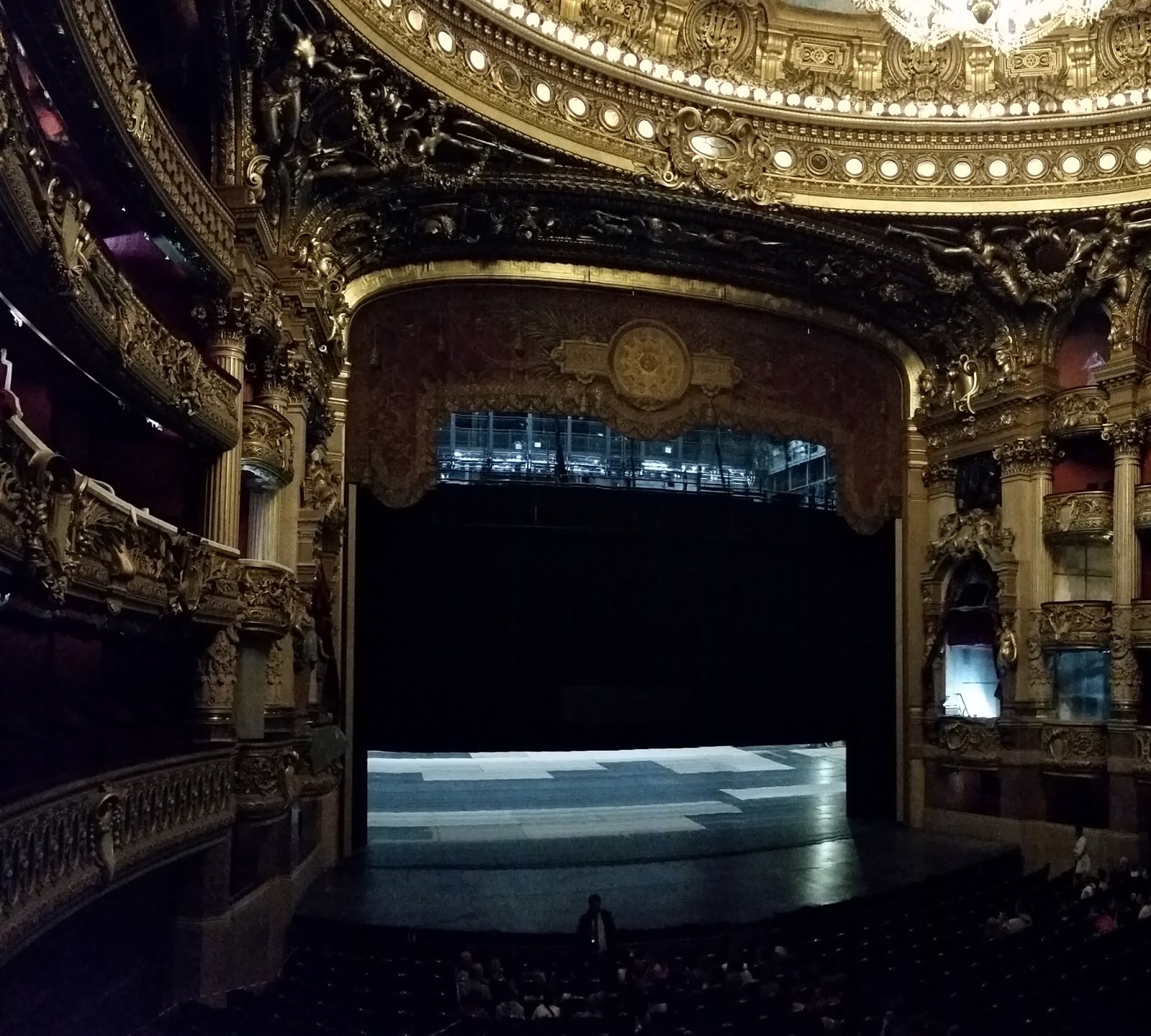As you know, I'm a big fan of unique architecture. In addition to palaces, castles, and cathedrals there are the theaters. Unfortunately, many amazing theaters have been destroyed (especially in the USA) and replaced with more-for-the-money highrises. Palaces and cathedrals survive, but theaters often suffer their demise because they can no longer mount modern productions that require larger stages and/or technological requirements. I've been very fortunate in my lifetime to stand and perform on some amazing theater stages both modern (such as the 2,500 seat Benaroya Hall in Seattle), historical (Carnegie Hall in NYC), and the stunning jaw-dropping (Palau de Musica in Barcelona). So, when I get a chance to experience a tour of the 'grand dames' of theaters, I leap at the chance.....and, well...fantasize of performing on their stage. The tour cost $14.
The Paris Opera House, is otherwise known as Palais Garnier for it's architect Charles Garnier. The 2,081 seat opera house is considered one of the worlds most famous, and beautiful theaters. Constructed between 1861 and 1875 (interuptions due to war and the Siege of Paris), it is said it follows the style principle of leaving no space without decoration. And, boy, did they!! It's functional and flambouyant at the same time. Some of my photos don't come out very well as there's soooo much detail it's hard to discern what is what.
After entering, you arrive at the lavish 98 ft high nave which houses the double staircase (shaped like a 'Y') that leads to the various levels of the auditorium. At the bottom of the staircase are "...two female allegories holding bouquets of light to welcome visitors".

How about some fun facts/stats?
- The Grand Foyer, where one might hang out during intermission, is 18 metres (59 ft) high, 154 metres (505 ft) long and 13 metres (43 ft) wide. To give that a perspective....about 20 double-wide mobile homes.
- The stage is the largest (89 ft deep, 159 ft wide (stage opening 52 ft)) in Europe and can accommodate 450 artists.
- The original stage curtain has only been replaced (exact replicas) twice in 150+ years...in 1951 and 45 years later in 1996.
- The bronze and crystal chandelier dangling inside the 197 ft tall horseshoe-shaped auditorium has 340 lights and weighs 8 tons (16,000 pounds!). I wonder how many molly bolts they used?
- The building itself is 567 ft long, 410 ft wide, and occupies a 3 acre site. There are over seventeen stories, seven of which are below the stage level.
On 20 May 1896, one of the chandelier's counterweights broke free and burst through the ceiling into the auditorium, killing a concierge. This incident inspired one of the more famous scenes in Gaston Leroux's classic 1910 gothic novel The Phantom of the Opera.
Golden angels on top of the Opera House look like a lady we all know in NYC!!
The ramps you see in the next photo were designed to allow secure and direct access to the interior of the theater by the Emperors' carriages.
Looking from the loggia (a terrace for the smokers)
Why is everyone always NAKED??
The first space you encounter upon entering is the Vestibule where you purchase tickets.
After the Vestibule, you're led to the Grand Staircase.
You wondered why I didn't address the 'elephant in the room' two photos back?
Titled Les Saturnales, two golden tractor tires on the grand staircase, were unveiled December, 2018 to celebrate the Opéra de Paris' (the Opera, not the building) 350th anniversary. Not surprisingly, it evoked a lot of ire from the public. One Twitter user wondered whether the opera house had been sponsored by Michelin, the French tire maker.
Soooooo much detail! And, opulence up the wazzoo!
As my Mom would say 'I wouldn't want to have to dust that!'
I dunno....I'm feelin a bit light-headed.
bwwwaahhhaahhahahaaa!!!
Inside the auditorium.
Multiple tiers of crushed velvet and privacy barriers.
The original artwork surrounding the central chandelier was replaced by this painting by Marc Chagall in 1964.
Here's a short video of the interior.
Nearby was another church I wanted to see due to it's elaborate stained glass windows.
St Chapelle
It was built in the 1200's and was part of the royal palace which was then located in the center of Paris. St Chapelle is noted for the its 15 stained glass windows which are each about 50 ft high.
While I was there, it began to rain....more like torrential pouring. I found a small protected space outside and waited for the rain to stop. It didn't. But, when it let up a bit, I headed out (sans umbrella). I was GOING to do the river cruise, but today was NOT the day for it. Instead, I headed back to the apartment.
Next up....Day 6...the Seine River Cruise!!
Dano

































No comments:
Post a Comment